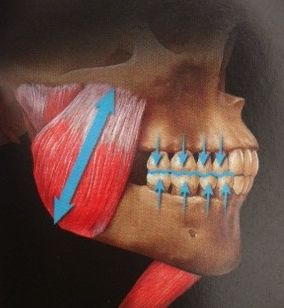Rehabilitation of temporomandibular joints
Dentysta stomatolog Warszawa Ursynów ADENTIS / Services / Rehabilitation of temporomandibular joints
Rehabilitation of temporomandibular joints
DYSFUNCTION
TEMPOROMANDIBULAR JOINT
Effective treatment begins with the correct diagnosis.
At Adentis, patients are cared for by:
dr Aleksandra Gabren Syller
Mgr Maciej Iwanowski, rehabilitation specialist

Treatment with bite splints is called splint therapy – not splint treatment. It is not possible to permanently cure temporomandibular joints with any splint. The splint is only used to eliminate pain, then treatment should be introduced – 90% of it should be orthodontic treatment with a prosthetic component, and 10% should be only prosthetic treatment.
Orthodontic treatment that can cure temporomandibular joint is only orthopedic appliances that change the position of the jaw to the mandible, and then orthodontic appliances. Tooth displacement alone may not cure the causes.
 |
 |
Source: Esthetic rehabilitation in fixed prosthodontics. Mauro Fradeani
Pathologies in the temporomandibular joint (TMJ) are a very common disease. It affects up to 20-40% of the total population. Symptoms of this condition include: joint pain, headache, crackling in the joints, limited or loss of mouth opening and others.
 |
 |
|
| temporomandibular joint (auditory foramen) | articular disc and pterygoid muscles | masseter muscle |
Temporomandibular joint
Teeth clenching can lead to most local, joint and general complications in the masticatory system and in the spine. The problem of excessive muscle tension or their disharmony (e.g. unilateral contracture of the lateral pterygoid muscle) in the work of both temporomandibular joints is the cause of most pain problems in our patients as well as the most common cause of dislocation of articular discs.

If you wake up with sore jaw muscles or a headache, it is also a signal to check for parafunctions that lead to tooth wear. . The forces released on the chewing surfaces of patients can be up to ten times greater than those acting during normal biting and chewing processes, which can lead to serious damage to the bite and, ultimately, to the destruction of the bone and gum tissue surrounding the tooth. Occlusal and non-occlusal parafunctions can cause tooth pain or loss, and sometimes teeth are literally partially worn away. Another serious consequence of parafunction is damage to the temporomandibular joints. Pathological changes in the joint may occur, which causes:
- crackles in the temporomandibular joint
- friction in the temporomandibular joint
- pain in various areas of the face
The temporomandibular joint is the only movable joint within the skull and one of the most frequently used joints in the body. This involves long-term use of this joint in the process of eating, speaking as well as singing, chewing gum, yawning, clenching teeth, etc.
Symptoms of temporomandibular joint disorders:
- crackles, crackles,
- mandibular deviation,
- pain in the muscles responsible for opening and closing the mouth
- headache and neck pain
- difficulties
- in opening the mouth,
- pain when chewing hard food
- pain around the ear
- tearing or pain around the inner corner of the eye

Temporomandibular joint disorders:
- developmental defects,
- muscle diseases (80%),
- disorders of the articular disc,
- degenerative changes.
Asymmetries in the skull cause rotation of the mandible, displacement of the jaw joints, skull deformations, headaches and others.
X-ray of the temporomandibular joints.
Causes of joint disorders:
- Malocclusion (jaw too far back, deep bite)
- Dental abnormalities (upper teeth tilted back)
- Missing teeth – missing back teeth
- Muscle overload (grinding or clenching teeth, bad posture)
- Head or jaw injuries (car accidents, rear-end collisions, post-intubation complications)
Treatment of the temporomandibular joint is very difficult due to its location. It involves treating the causes of temporomandibular joint dysfunction and treating habits – parafunctions.
 |
 |
| Degenerative changes in the joint. | Articular disc dislocation. |
Causes and consequences of damage to the temporomandibular joint:
- stress
- clenching and grinding of teeth leading to their destruction (bruxism),
- strong tension of the muscles that clench the jaw,
- arthritis,
- mechanical trauma causes changes in the structure of the temporomandibular joints.
Diagnosis of temporomandibular joint disorders:
- manual examination,
- interview
- manual analysis of temporomandibular joints,
- functional X-ray of the jaws closing and opening.
The pantomogram does not show the full injury of the temporomandibular joints, but it shows whether there are any abnormalities
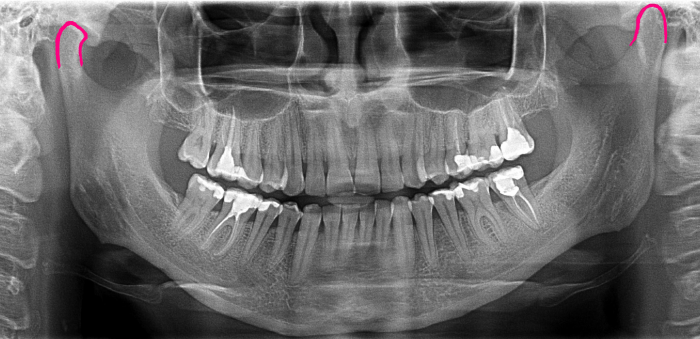
Treatment of temporomandibular joint disorders:
- dental and prosthetic treatment,
- physiotherapy, used to reduce joint tightness and improve muscle flexibility,
- physical therapy – magnetic field, laser therapy, electrotherapy, heat or cold therapy,
- relaxation exercises to reduce stress,
- self-therapy – learning exercises.
- The pain caused by teeth clenching is a dull, diffuse, deep and radiating pain.
- Temple pain may suggest frontal sinus diseases.
- Pain in the pre-auricular area – diseases of the hearing organ.
- Pain in a group of teeth often occurs, but it is not known which one is causing the pain.
Sometimes the patient claims that all the fillings hurt. The persistent pain prompts him to seek help from various specialists until he finally goes to a dentist.
Structure of the temporomandibular joint: The temporomandibular joint is a paired joint and is the only joint that always works together with the joint of the opposite side.

The pond includes:
- articular fossa of the temporal bone,
- articular (condylar) process of the head of the mandible,
- articular disc
- joint capsule.
As the jaw is lowered, the disc moves forward and downward. The articular process of the head of the mandible moves simultaneously with the disc (symmetrical movement). During adduction of the mandible (closing the mouth), the articular disc and the condylar process return to their starting position.
The temporomandibular joint (temporomandibular joint) is a paired and unique joint due to its two-story structure, which allows the performance of complex:
- jaw opening and closing movements
- progression and retraction of the mandible
- crushing and crushing food
- chewing.
The action of both joints is interconnected and allows the above-mentioned movements to be performed simultaneously.
Internal temporomandibular joint disorders are associated with:
- abnormal development (deep temporomandibular fossa, poorly developed articular tubercle, flat form of the joint)
- asymmetries of individual joint elements – often associated with facial asymmetry,
- occlusion and articulation abnormalities,
- short-circuit and non-short-circuit parafunctions.
They cause unphysiological positioning and abnormal movements of the articular disc, accompanied by pain, sound symptoms and limited jaw mobility.
Other SSJ diseases include degenerative disease, injuries and cancer processes.
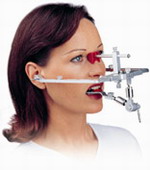
Temporomandibular joints (TMJs) are the most frequently used joints in our body. They are involved in the process of speaking, eating, singing and yawning. The teeth come into contact for approximately 30 minutes a day. Mainly when swallowing saliva. Improper dental contacts caused by e.g. tooth loss or bruxism cause stress in the temporomandibular joints, which may lead to occlusal disease.
Tooth loss can be caused by tooth decay, gum disease and improper occlusion. Occlusal disease causes tooth destruction due to improper contact between the maxillary and mandibular teeth.
At Adentis, each patient with diagnosed occlusion disorders who undergoes treatment with us has an x-ray taken.
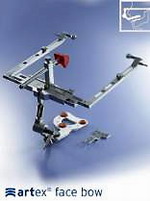
panoramic x-rays, photos of occlusal conditions with a digital camera and we analyze the occlusion using a face bow from the Austrian company AmannGirrbach, which is a leader in the field of creating new technologies in dentistry and prosthetics. At ADENTIS, we analyze the masticatory system in great detail. This test involves analyzing occlusion and articulation (bite) on models. Thanks to this approach, we can detect hidden irregularities and causes of pain, tooth abrasion, cracks in prosthetic restorations, periodontal bone destruction and temporomandibular joint disorders.
ARTEX FACEBOW (Representative – Natrodent)
The Artex facebow allows you to quickly transfer the patient’s cranial and maxillofacial relationship to the articulator. Thanks to the universal 3-D transfer, this arch has been recognized as the fastest and most practical device of this type available on the market.
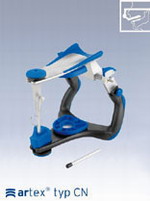
- Opened symmetrically without changing the sagittal distance from the jaw
- Absolutely necessary for the diagnosis and treatment of joint and occlusal dysfunctions
- Records the anatomically correct jaw-joint relationship in max 2 minutes
- Transfers patient information and data to the articulator
- Minimizes the correction time of prosthetic work in the dental chair
Adentis WELCOME
WITH PAIN – no one wants to live!
What is dental rehabilitation?
It is the restoration of proper function so that the patient can function properly.
It is not only about straight teeth, but also about the correct position of the lower jaw to the upper jaw.
This restores the correct mechanical pattern of the cranial system and improves the functioning of the entire skeletal and muscular system.
What is functional orthodontics?
Teeth are crooked because something is crooked!
Restoring proper function is a stable effect of treatment and your health.
Functional orthodontics is facial modeling.
If:
- you breathe through your mouth,
- You have crooked teeth,
- you have an unattractive facial profile,
- you have an asymmetric face,
- You clench your jaw,
- you grind your teeth,
- you have a headache,
- you have incorrect body posture, you slouch
- you eat with your mouth open,
- you have migraine headaches
- you snore,
- clicks in your jaw joints
- you have bruxism,
- Your tongue position is incorrect.
Then I invite you to a CONSULTATION
If you want the treatment effect to be stable – it is worth restoring proper function.
Dr. Aleksandra Gabren
Maciej Iwanowski, M.A., rehabilitation specialist

